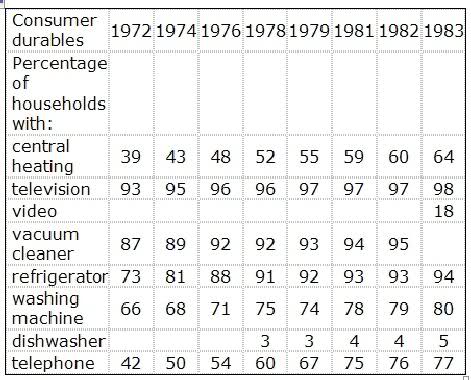The table below shows the consumer durables(telephone,refrigerator,etc) owned in Britain from 1972 to 1983.
CAN YOU HELP ME SCORE MY ESSAY PLEASE?
he table below reveals several information about the consumer durables used in Britain during the period from 1972 to 1983.
Bristish had the highest demand on TV than others household. The rate of people using this item fluctuated during the period from 93% to 98%.
At the second place, refrigerator had the rate of being used being 73% (1972). This figure increased slightly ove94%r the following years then the time between 1972 and 1974 had seen the significant growth by 8% of this rate which finally reached the peak at 94% in 1983.
In contrast, video was the least commonly consumed house device in Britain. No one used it since 1972 until 1983 when the percentage of consumer of this item increased markly to 18% in 1983.
Similarly, Bristish had not had the demand on dishwasher in 4 years since 1972. Suddenly, 3% of them started using this machine in 1978. The rate of costumers had been slighly rising from 3% to 5% in 1983.
On the contrary, vacuum cleaner was one of the most popular household also with the number of users approximately equal to those of refrigerator in a decade since 1972. However, in 1983, the rate of people used it strongly declined from 95% to the bottom of 0.
Washing machine, telephone and central heating were items that had the medium-high amount of consumers with the percentage of users rise regularly from year to year. The highest rate of consuming these 3 households were respectively 64% in 1983 of central heating, 80% of washing machine, 77% of telephone in 1983.
In conclusion, TV always played the most important part in British's house followed by refrigerator, washing machine, telephone, etc. Videos and dishwasher were less popularly used than others household mentioned above with the change of living condition.
CAN YOU HELP ME SCORE MY ESSAY PLEASE?
he table below reveals several information about the consumer durables used in Britain during the period from 1972 to 1983.
Bristish had the highest demand on TV than others household. The rate of people using this item fluctuated during the period from 93% to 98%.
At the second place, refrigerator had the rate of being used being 73% (1972). This figure increased slightly ove94%r the following years then the time between 1972 and 1974 had seen the significant growth by 8% of this rate which finally reached the peak at 94% in 1983.
In contrast, video was the least commonly consumed house device in Britain. No one used it since 1972 until 1983 when the percentage of consumer of this item increased markly to 18% in 1983.
Similarly, Bristish had not had the demand on dishwasher in 4 years since 1972. Suddenly, 3% of them started using this machine in 1978. The rate of costumers had been slighly rising from 3% to 5% in 1983.
On the contrary, vacuum cleaner was one of the most popular household also with the number of users approximately equal to those of refrigerator in a decade since 1972. However, in 1983, the rate of people used it strongly declined from 95% to the bottom of 0.
Washing machine, telephone and central heating were items that had the medium-high amount of consumers with the percentage of users rise regularly from year to year. The highest rate of consuming these 3 households were respectively 64% in 1983 of central heating, 80% of washing machine, 77% of telephone in 1983.
In conclusion, TV always played the most important part in British's house followed by refrigerator, washing machine, telephone, etc. Videos and dishwasher were less popularly used than others household mentioned above with the change of living condition.

